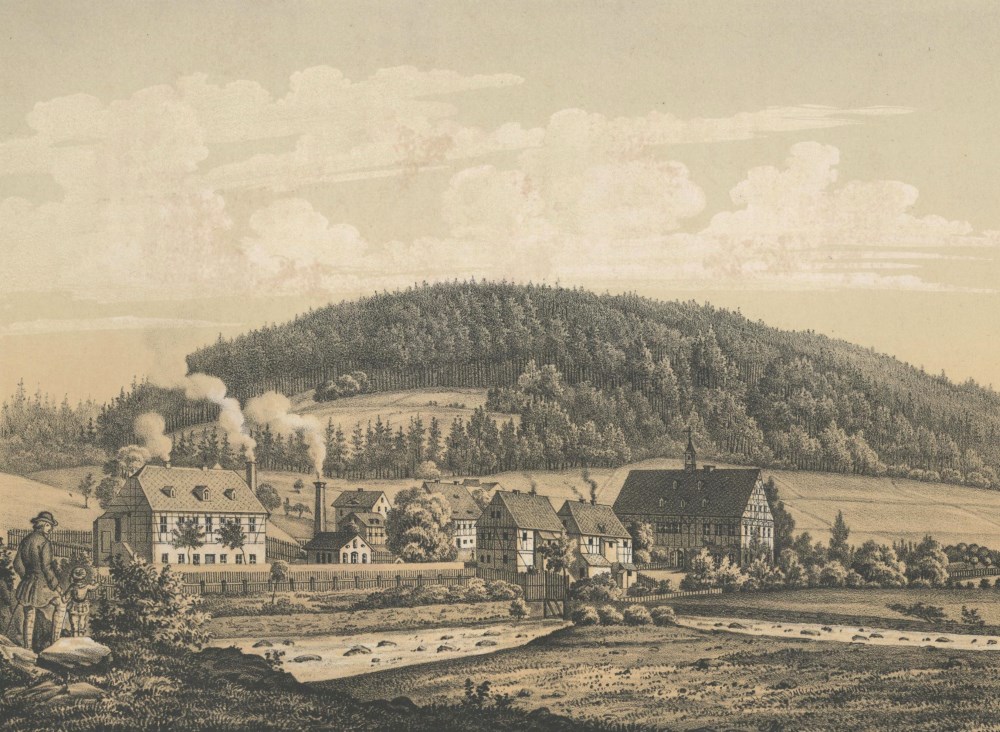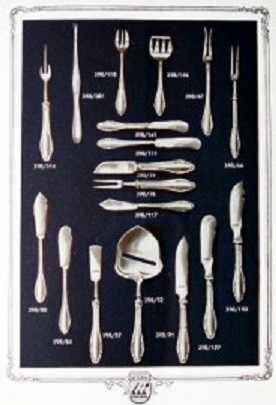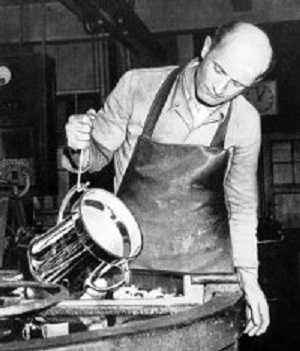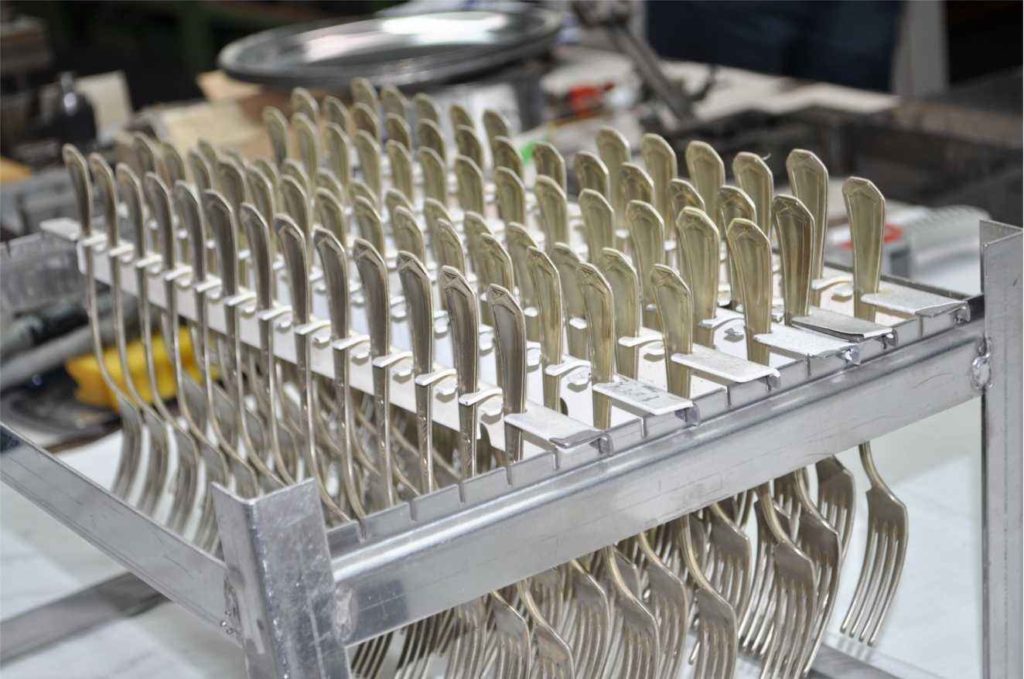Our history
We invite you on a journey of discovery into the world of grand hotels and starred restaurants, festive banquets and exquisite taste. Come and immerse yourself with us in the world of Wellner – silverware for the best tables in the world.
1823
A significant invention: the nickel silver
Around 1823, the Auer Valley became the birthplace of an invention whose consequences were to be of the greatest importance for German industry in general and the emergence of first-class cutlery manufacturing in the Ore Mountains. Dr. Ernst August Geitner, known as a tinkerer, inventor and chemist, invented Argentan, an alloy of copper, nickel and zinc, which we know today as German silver.

1834
The cradle of the Wellner manufactory
The ancestor Christian Wellner first worked as a miner and forestry worker in Aue in his younger years. Later, he found employment in Dr. Geitner’s nickel silver factory, where he learned the various manual steps of nickel silver production. Following the urge to become independent, he bought a Zainhammer on the Mulde River in 1834 with money he had borrowed from his brother and set up a foundry and associated rolling mill in it. From then on, he and his family worked in their own manufactory.


1854
Foundation of the Wellner manufactory
During his lifetime, his father divided the inheritance between his two sons. While the younger son Christian Gottlieb received the Zainhammer in 1854, the then 30-year-old Carl August Wellner received the previously acquired smelting works, in which he built up the still young spoon production by hand and under his own name. From then on, his brother Gottlieb supplied the nickel silver required for this purpose. A few years later, Carl August Wellner also acquired the long mill in Aue in order to build up an independent plant on the extensive property.
1861
Transition to machine production
With the onset of industrial development, Carl August Wellner also switched to machine-based spoon production. His close friend Erdmann Kircheis, whose company cradle in the Zainhammer was under Wellner’s roof and who later became world-famous in mechanical engineering, supplied the first spoon rolling mill. This laid the foundation for machine-based production and initiated the development that subsequently led the name “August Wellner” to world fame.

1887
New section in sales development
While the company’s founder, Carl August, placed great emphasis on the quality of his cutlery, sales remained below his means. In response to the growing demand, an agreement was reached in 1887 with the family’s business friend, the Leipzig merchant Karl Krause, which made Krause the sole seller of the entire cutlery range of the Wellner manufactory. In addition to the establishment of a branch office in Leipzig, this also led to the later marketing of Wellner cutlery in Spain and America.

1892
Saxon Metalware Factory August Wellner Sons
In the fall of 1892, the then 67-year-old company founder handed over the 100-man company to his three children and long-time employees Ernst Albin, Paul Richard and Ida Marie, as well as to his son-in-law, Peter Paul Gaedt. Under the name “Sächsische Metallwarenfabrik August Wellner Söhne” (Saxon Metalware Factory August Wellner Sons), the manufactory was entered in the commercial register of the Schneeberg district court on October 20, 1892. Despite the handover, the company’s founder Carl August remained faithful to his daily work at the foot-operated lathe until shortly before his death, paying strict attention to the first-class quality of the silverware produced. It was – and remains to this day – a matter of course that no piece of cutlery should leave the manufactory with even the slightest doubt as to its perfection.


1913
Cutlery for luxury liners and Grand Hotels
Under the leadership of Peter Paul Gaedt, who constantly invested in new types of more powerful drive systems, the company grew to over 1,000 employees. The investments did not allow for reserves and demanded every single member of the Wellner and Gaedt families. Hard work and privation led the family business and Wellner’s silver products to world fame in the years that followed. “Wellner silver” became synonymous with German workmanship. It not only adorned the boards of the world’s largest luxury steamer at the time, the Imperator, which traveled between Hamburg and New York for the HAPAG shipping company, but also those of the glamorous luxury hotels of the time, such as the Mena House Hotel near the pyramids of Giza, the famous Hotel Adlon in Berlin or the fashionable Maloja Palace in St. Moritz.
1924
Cutlery from the Wellner manufactory dominates the international market
With 11 branches throughout Germany, 47 foreign representatives and over 5,000 employees, Wellner successfully held its own against companies such as Christofle in Paris, KRUPP Berndorf near Vienna or the Sheffield cutlery factories and continued to expand its leading position in the production of the finest silverware. Almost every second upscale hotel, restaurant, coffee house, casino or society house of that era had Wellner silverware in use. Likewise, many of the grand and glamorous ocean liners dined with fine Saxon silverware, carrying the culture of dining around the world.

1930
The largest assortment ever
With over 122 models, Wellner had the largest cutlery assortment of all time in 1930, which included numerous design models created by famous architects and artists. From Peter Behrens (1868 – 1940), one of the most influential architects and product designers of the early 20th century, comes the cutlery “No. 124” from 1902; such a special cutlery that one copy is in the possession of the Neue Sammlung in Munich, one of the world’s leading design museums. Another design model, “No. 130” with a cant pattern, was created in 1904 by the multi-talented Joseph Maria Olbrich (1867 – 1908). In addition to this Wellner cutlery classic, Olbrich created some of the great icons of Art Nouveau architecture: the Vienna Secession, the buildings of the artists’ colony on Darmstadt’s Mathildenhöhe, and the Tietz luxury department store on Düsseldorf’s Königsallee.

After 1945
New beginning after the war
After the end of the Second World War, the traditions of Wellner’s cutlery production were slowly resumed under the name “Auer Besteck- und Silberwarenwerke (ABS)” under difficult conditions. After years of arduous reconstruction, the proven craftsmanship talent for cutlery production was once again recognized and awarded international prizes.

After 1990
Eventful years
After the reunification of Germany and the eventful years that followed, the tradition-rich company was once again faced with major changes. Of the former 5,000-plus employees, only 500 were still employed at the Aue site in 1990. After years of mismanagement and several attempts to revive the business, cutlery production continued in the following years with a small workforce.


Since 2001
Renaissance of Wellner
Finally, in 2001, the remaining production facilities of the once glorious company were up for sale. Siegfried Günzl, a long-time employee at the Auer Besteck- und Silberwarenwerk, decided, against numerous opinions and advice, to protect the remaining Wellner heritage and to continue the tradition of Saxon silver processing in the Ore Mountains. Like once Christian Wellner, more than 160 years before, he pursued a clear goal.
With the vision of restoring the Wellner brand to its original glory, he preserved the old patterns, molds and machines for continued existence. Recalling the values of the company founder Carl August Wellner, the renaissance of the Wellner brand thus took place. The necessary production facilities were found in neighboring Schneeberg, where luxurious silver cutlery and tableware have once again been manufactured in the traditional manner ever since. Today, as then, the Wellner brand embodies not only the highest dining pleasure and exquisite taste, but also continuity in the pursuit of perfection and aesthetics.
